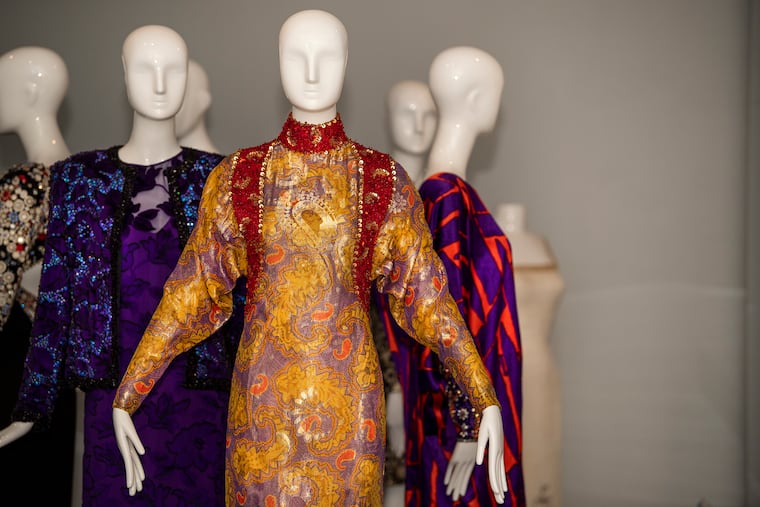Drexel University fashion exhibit celebrates the life of Philadelphia’s James Galanos | Elizabeth Wellington
An exhibit, honoring James Galanos, who in high-brow fashion circles is known as former first lady Nancy Reagan's go-to couturier, opened at Drexel University's Pearlstein Gallery earlier this month.

Fashion has its fair share of haute hit makers turned household names, like Oscar de la Renta, Hubert de Givenchy, and Coco Chanel.
However, I've learned it's often the designers without a string of licenses who, quite honestly, have made more impact.
I'm thinking of Claire McCardell, the mid-20th-century women's wear designer who's considered the creator of American sportswear, thanks in part to her pretty shirtwaists and pleated trousers. There is also French designer Madeleine Vionnet, who, among her many claims to fame, counts the invention of the bias-cut gown. Have you heard of her?
And then there is perhaps the most unsung American fashion designer: Philadelphia-born James Galanos. But fear not, my fashion chickadees, the time to learn about Galanos' contributions to fashion is now. Among them: He elevated pants and pantsuits to dressy and brought another level of sophistication to the column gown — still a red-carpet staple — by fashioning it from chiffon and adding luxe drape detail and metallics, giving the relatively simple dress design movie-star sparkle.
An exhibit honoring the late designer, known in high-brow fashion circles as former first lady Nancy Reagan's go-to couturier, opened at Drexel University's Pearlstein Gallery last month.
"James Galanos: Design Integrity" is composed of 60 classic Galanos looks spanning his 47-year career. On the daises are 1950s shirtwaists, 1970s elongated tunics, 1980s Dynasty-style drama (bring on the sequins!) and clean, columned gowns of the 1990s. The little black dresses — smack dab in the center of the 4,000-square-foot exhibit — span every decade.
Shortly after Galanos' death in 2016, Drexel received 750 of his original samples — pieces his models wore on runways, in trunk shows, and in fashion glossies — as well as a host of sketches and photographs. The collection was a gift from the Galanos family.
I met with the exhibit's lead curator, Clare Sauro, as she put the finishing touches on the show. She gave me a fashion education about Galanos' legacy.
Who was James Galanos?
James Galanos was born in Philadelphia. He moved to New Jersey, though, when he was very young … He went to design school [in New York] for eight months. And then he said, 'I'm done.' He took a job for [Depression-era fashion entrepreneur] Hattie Carnegie before accepting a position at a Los Angeles design house. But before he even got there, the company went out of business. The businessman, feeling guilty, sent Galanos to Paris, where he took an unpaid internship at the House of [Robert] Piguet. There, he became an assistant designer in about 1947. When he was there, he worked alongside Givenchy, with whom he remained friends for years, and Marc Bohan. [In 1960, Bohan replaced Yves Saint Laurent as creative director of Dior.]
[Galanos] eventually returns to Los Angles. This is 1951. He borrows $200 and makes a seven-piece collection that he sold to retail buyers, including the Amelia Gray boutique in Beverly Hills. He takes off from there.
Is this how Galanos connects with the movie stars of his era?
Yes. The Amelia Gray boutique is where many of these women shop. … His celebrity clients included the model Dovima [the 1950s American model whose real name was Dorothy Virginia Margaret Juba. A picture of her wearing an olive green Galanos is one of the photographic anchors of the exhibit.] He also designed for Rosalind Russell. [Sauro points to a pumpkin skirt suit] One of his most vocal supporters is Diana Ross. This [long-sleeved metallic] purple dress here. I found a picture of Diana Ross wearing [a version] of this dress in 1984, when she presented an Academy Award with Tom Selleck.
Cool. So tell me about Galanos’ relationship with Nancy Reagan.
[Sauro walks over to a dais full of rainbow-hued draped dresses, including an emerald green gown with long sleeves, high neck, and a blousson back. Reagan wore a red silk version of it for her first official White House portrait.] Galanos' and Nancy Reagan's relationship went back before she married Ronald Reagan, when she was an actress. She was among the actresses who helped him shoot to fame in the 1950s and 1960s, but then his status reached a whole other level in the 1980s while Nancy Reagan was in the White House. Galanos was her preferred designer. And it was a bit controversial, too. Those clothes cost a lot of money. … But she was in keeping with what had always been. He did become a household name for a bit. There were articles about him in the press … But eventually — how can I put it — you know the kind of designers that chase the press? Well, Galanos just wasn't one of them.
That is why there are no Galanos’ licenses. No fragrances? No sunglasses?
Exactly. He was self-funded and for the most part financially secure.
What kind of silhouettes are Galanos remembered for?
He preferred elongated silhouettes, long tunics, broad shoulders. He liked working with different textures: chiffon, taffeta, lace, chenille, lurex. And he loved bifurcation [that would be pants] He loved jumpsuits. He was doing pantsuits from as early as 1956. He was pretty radical.
ON EXHIBIT: James Galanos: Design Integrity October 19- December 8, January 8-27 2019 in Drexel University's Leonard Pearlstein Gallery, 3401 Filbert Street; Hours: Tuesday-Sunday 11 a.m. to 6 p.m. Closed Mondays. Admision: Free